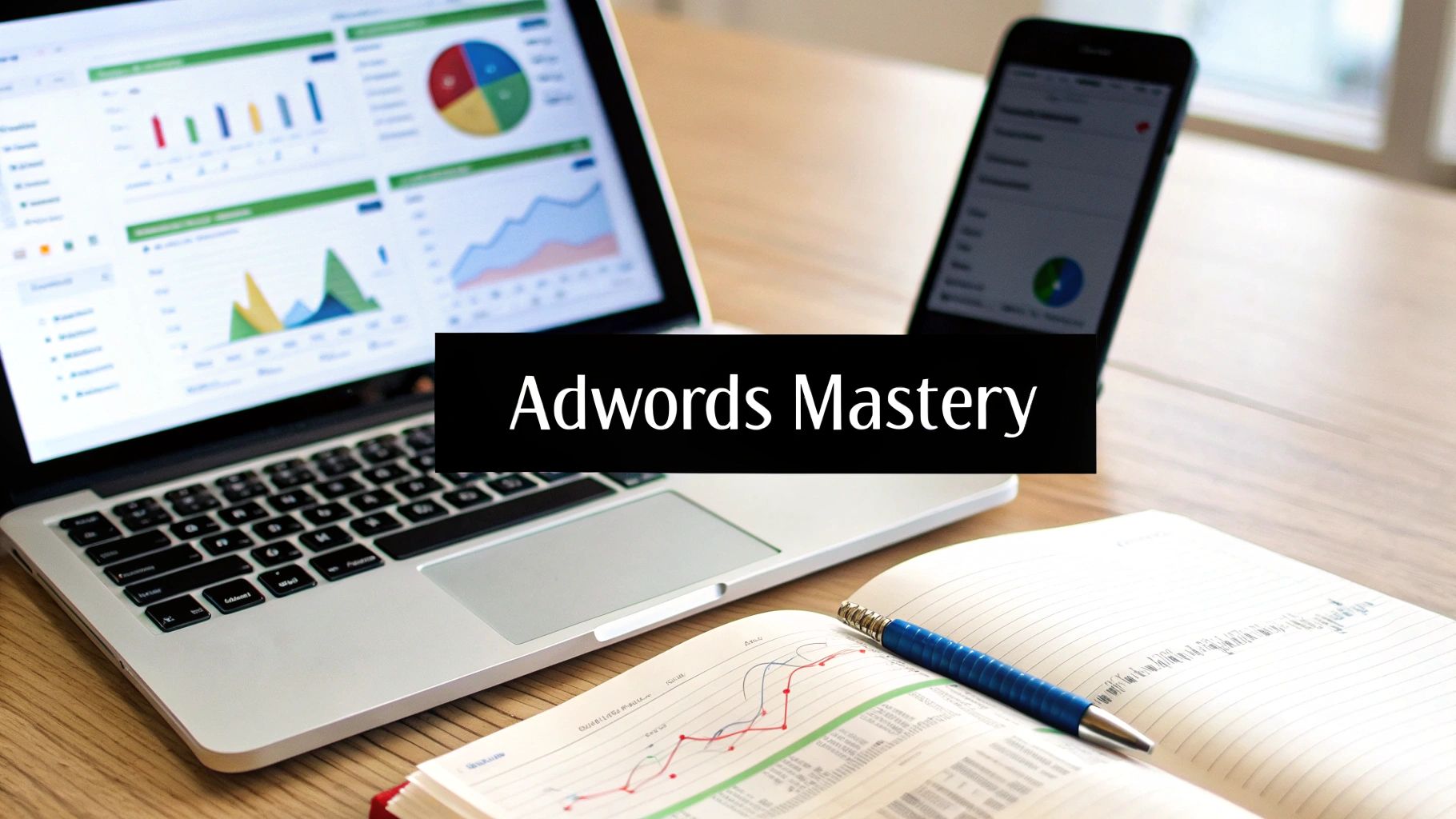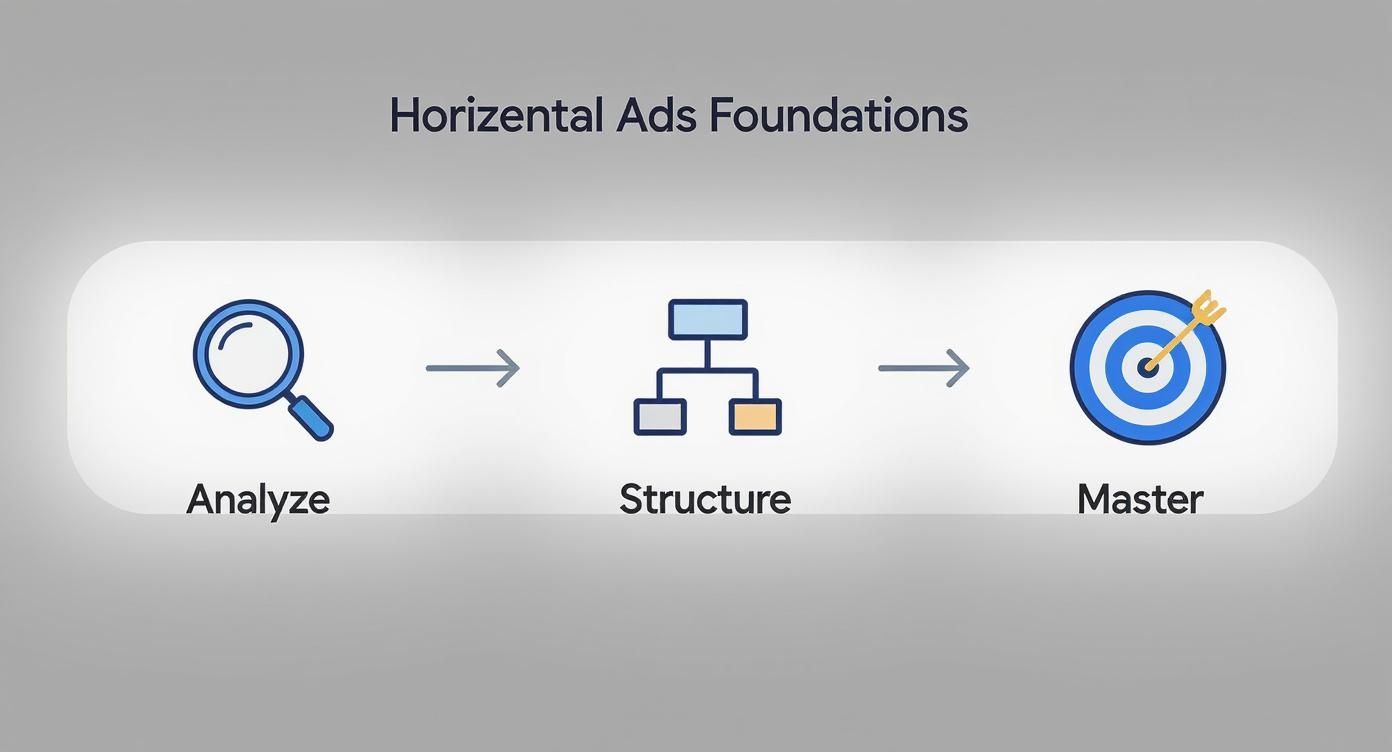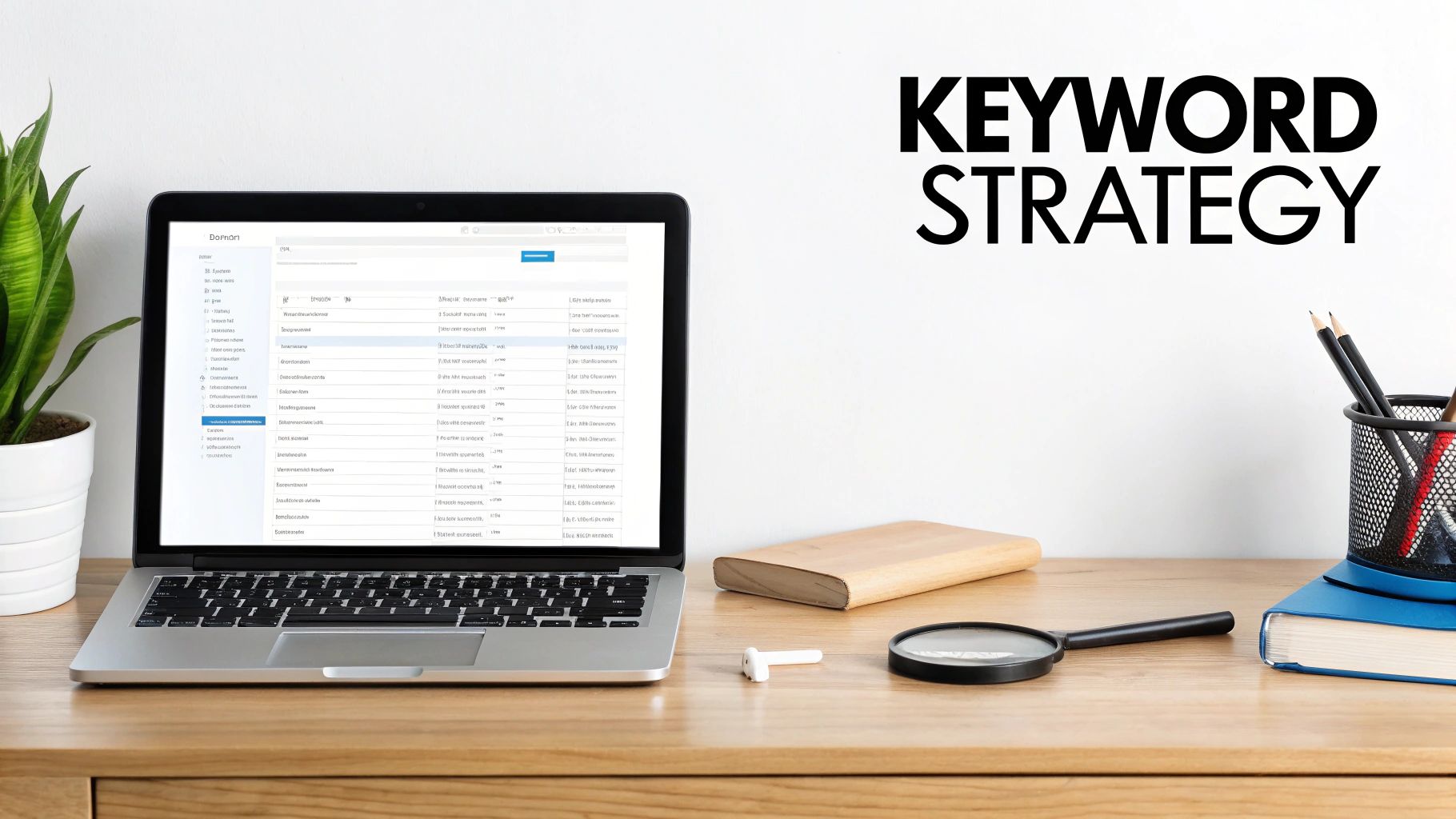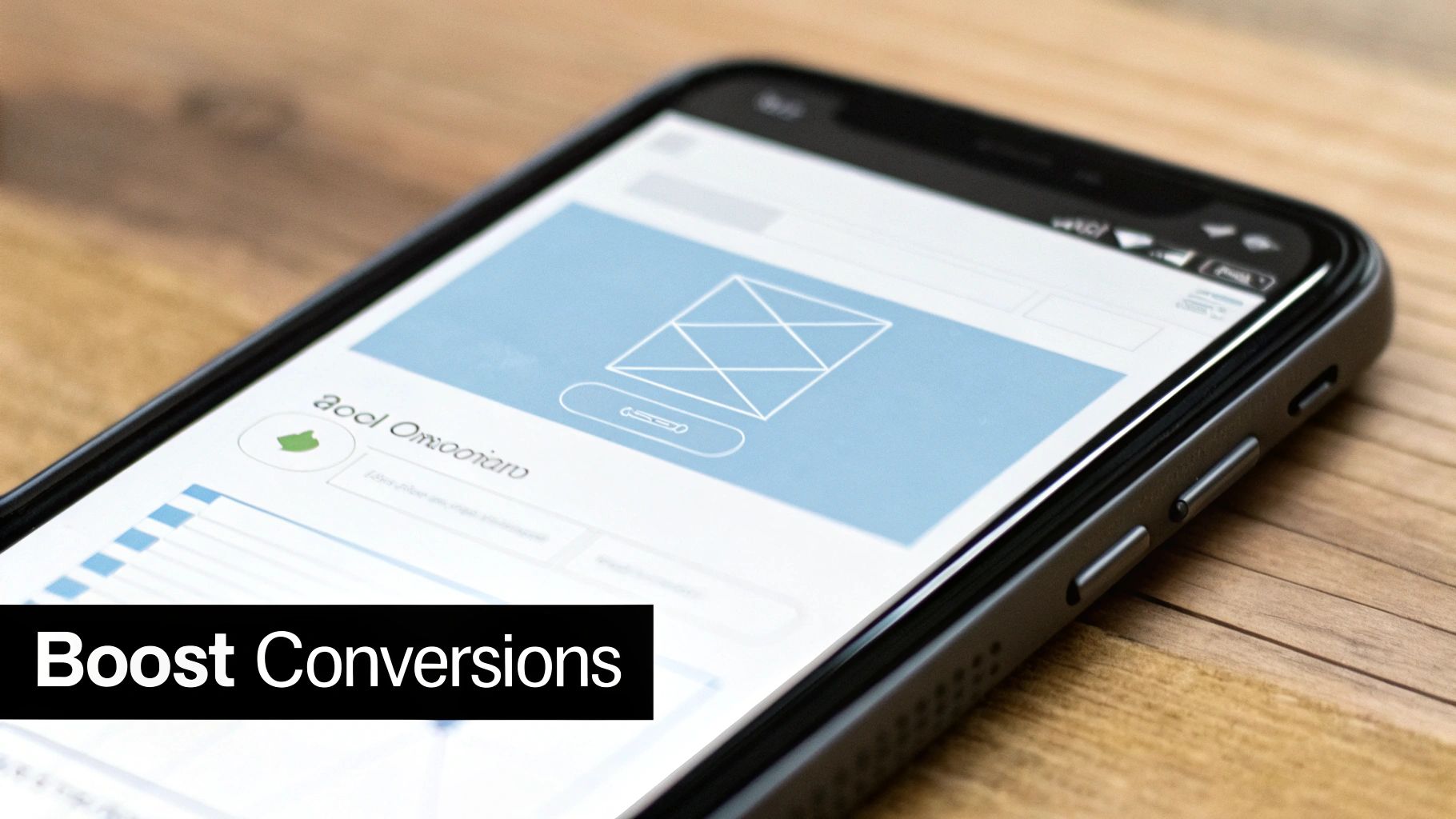October 31, 2025
Google AdWords Optimization Your Guide to PPC


Google AdWords optimization is all about tweaking your campaigns to get the best possible results. Think of it as a process of continuous, small improvements—adjusting keywords, bids, and ad copy—to squeeze every drop of value out of your ad spend and stop wasting money.
Your Starting Point For Better Google Ads
Ever feel like you're just lighting money on fire with your Google Ads campaigns? You’re definitely not alone. It’s an incredibly powerful platform, but it’s also complex enough to make even experienced marketers sweat. In fact, many small businesses admit to wasting 25% or more of their paid search budget. That's a huge sign that a "set it and forget it" mindset just doesn't cut it.
This guide is designed to give you a clear, no-fluff roadmap to actually optimizing your Google Ads. Forget searching for secret hacks; real success comes from mastering the fundamentals.
Mastering The Fundamentals First
We're going to start with the foundational pieces that make or break a campaign. Before you even think about fancy bidding strategies or complex audience segments, you have to get the basics right. A high-performing campaign is built on three pillars:
- Strategic Analysis: Knowing your market, your goals, and what your competitors are up to.
- Logical Structure: Building your account in a way that’s easy to manage and makes sense to Google's algorithm.
- Precise Targeting: Making sure the right people see your ads at the right moment.
A crucial first step, before you even touch your own account, is a deep dive into an AdWords competitor analysis. What you learn here will shape everything from the keywords you choose to the ad copy you write.
This simple flowchart shows how to think about building your Google Ads foundation—it's all about analyzing, structuring, and then mastering your campaigns.

The big takeaway here is that each step builds on the last. Get them in the right order, and you'll have a stable base for campaigns that can actually grow and turn a profit.
So many advertisers make the mistake of jumping straight into tactics without a real strategy. You could write the most compelling ad copy in the world, but if it’s buried in a messy account and targeting the wrong keywords, it's dead on arrival.
By focusing on these core principles first, we're laying the groundwork for everything else to come. You'll be setting your campaigns up for long-term success and avoiding the costly mistakes that trip up so many others. Let's get started.
Mastering Keywords And Match Types

Let's be blunt: your keyword strategy is the absolute heart of your Google Ads campaign. If you mess this up, you're basically paying Google to send you the wrong customers. It's the fastest way to burn through your budget with nothing to show for it.
Effective google adwords optimization isn't about bidding on every keyword under the sun. It's about getting inside your customer's head and understanding what they're actually typing into the search bar when they need what you offer. This is where the real work—and the real money—is made.
The Art of Intent-Driven Keyword Research
Forget just grabbing the most obvious, high-volume keywords. Sure, a term like "running shoes" gets a ton of searches, but the intent behind it is all over the place. Is that person just browsing? Looking for pictures? Writing a school report? Who knows.
The real gold is in long-tail keywords—those longer, more specific phrases of three to five words. A search for "buy waterproof trail running shoes for men" is a completely different ballgame. The intent is crystal clear: this person has their wallet out and is ready to buy.
Focusing on these longer keywords gives you some massive advantages:
- Lower Competition: Far fewer advertisers are bidding on these hyper-specific terms, which often translates to a lower cost-per-click (CPC).
- Higher Conversion Rates: The traffic is simply more qualified. You're matching a specific solution to a specific problem.
- Better Quality Score: High relevance between the keyword, your ad, and your landing page is exactly what Google wants to see, and it will reward you for it.
A great place to start digging for these gems is your own Search Terms Report right inside Google Ads. It shows you the actual queries people used to find your ads. You'll often uncover high-intent phrases you never would have thought of on your own.
Decoding Match Types for Surgical Targeting
Okay, so you've found the right keywords. That's only half the battle. Now you have to tell Google how closely you want it to stick to those keywords. This is done with match types, and getting them right gives you incredible control over your ad spend.
Think of it like giving directions. You can give broad, general directions or incredibly precise, turn-by-turn instructions.
The trick is knowing when to use which one. Here’s a quick guide to help you make the right call for your campaigns.
Keyword Match Type Strategy Guide
A breakdown of when to use each keyword match type for optimal campaign performance and budget control.
Ultimately, a smart strategy often involves using a mix. Start broader to gather data, then use that data to double down on your winners with Phrase and Exact match.
A classic rookie mistake is dumping all keywords into one ad group on broad match and just hoping for the best. A much smarter approach is to segment your keywords by intent and use progressively stricter match types as you identify your top performers.
The Unsung Hero: Negative Keywords
One of the most powerful—and most neglected—tools for google adwords optimization is the negative keyword list. These are the terms you tell Google you don't want your ads to show up for.
Imagine you sell premium, high-end coffee beans. You'd definitely want to add negative keywords like "free," "cheap," and "instant" to your campaigns. This simple action stops your ads from showing to people looking for something you don't offer, saving you from paying for worthless clicks.
For a deeper dive, our guide on AdWords keyword optimization covers how to build a robust negative keyword strategy from the ground up.
Building a solid negative keyword list isn't a one-time task. It's an ongoing process. You should be regularly reviewing your Search Terms Report and adding any irrelevant queries to your negative list. This continuous cleanup is what separates a well-oiled campaign from a leaky, inefficient one.
Let Google’s AI Do the Heavy Lifting with Automated Bidding

If you're still in the weeds tweaking your bids by hand every day, I've got some news for you: you're working way too hard. The real muscle in modern google adwords optimization is letting Google's AI take the wheel with its automated and Smart Bidding strategies.
Think about it this way. You could try to manually adjust your car's engine timing while you're cruising down the highway, or you could trust the onboard computer that's processing thousands of data points every second to do it for you. Google's algorithm has access to signals and patterns a human could never hope to catch in real-time. It’s all about working smarter.
This isn't just a shiny new trend; it’s a proven way to get better results. By 2025, it's predicted that over 70% of advertisers will be using automated tools like Target CPA. That’s a huge leap from just 35% back in 2020. Why the massive shift? Campaigns that fully embrace Smart Bidding see, on average, a 20% improvement in conversion rates.
Picking the Right Automated Bidding Strategy for Your Goals
Google gives you a full menu of bidding strategies, but there's no "one-size-fits-all" answer. The right choice comes down to what you're actually trying to accomplish with your campaign.
Let's break down the main players:
Maximize Conversions: This is your bread and butter for lead generation. If your goal is to get as many form fills, phone calls, or sign-ups as possible within your budget, this is the one to pick. You set the daily spend, and Google’s algorithm goes to town finding you the most conversions it can for that money.
Maximize Conversion Value: Selling products online? This strategy is your best friend. Instead of just chasing the number of sales, it focuses on generating the most revenue. It’s smart enough to prioritize users who are more likely to buy your higher-priced items.
Target CPA (Cost Per Acquisition): This one puts you back in the driver's seat when it comes to cost control. You tell Google exactly what you're willing to pay for a new customer, and it adjusts bids to hit that average CPA. It’s perfect if you have a solid understanding of your customer acquisition costs.
Target ROAS (Return on Ad Spend): For those who live and die by profitability, this is the ultimate goal. You set a specific return you want for every dollar spent. For example, a target ROAS of 500% tells Google you want to generate $5 in revenue for every $1 you spend on ads.
For a deeper dive into how these stack up, our guide on PPC bidding strategies can help you lock in the perfect approach.
You Have to Feed the Machine Good Data
Automated bidding is powerful, but it's not a magic wand. It's a machine learning system, and like any learning system, the quality of its output depends entirely on the quality of its input. Garbage in, garbage out.
The single biggest mistake I see people make is jumping to an automated strategy before their account has enough conversion data. The algorithm needs a history of at least 15-30 conversions in the last 30 days to really understand what it's doing. Without that foundation, it's just flying blind.
This is exactly why having your conversion tracking dialed in isn't just a "nice-to-have"—it's an absolute must for successful google adwords optimization. Make sure you're tracking the actions that truly move the needle for your business.
Once you flip the switch to an automated strategy, take a deep breath and be patient. The algorithm will enter a "learning period" that usually lasts one to two weeks. Your performance might look a little wild during this time. Don't panic. Let the machine do its thing. It's analyzing countless signals—device, location, time of day, audience lists—to figure out what drives results for your business. The hardest part is often resisting the urge to tinker, but it's essential for long-term success.
Optimizing Your Landing Pages For Conversions

You can write the most brilliant ad in history, but if it leads to a slow, confusing, or totally irrelevant landing page, you’ve just paid good money for a click that’s going nowhere. The landing page is where the magic happens—or doesn't. It's the final, make-or-break step in your ad's journey.
A clunky landing page experience doesn't just lose you a potential customer; it actively poisons your entire campaign. Google watches what happens after the click, and a poor user experience will absolutely tank your Quality Score. That means higher costs and lower ad visibility.
Think of it this way: your ad makes a promise, and your landing page has to deliver on it.
Creating a Seamless Ad-to-Page Experience
The first and most important rule here is message match. The headline on your landing page needs to mirror the headline of the ad that brought the visitor there. If your ad promises "50% Off Winter Coats," your landing page better be screaming that exact offer right at the top.
This immediate confirmation tells people they’re in the right place, building trust from the get-go. It kills confusion and slashes bounce rates because you're delivering exactly what they expected. This one detail is a huge part of effective Google Ads management.
Key Elements of a High-Converting Landing Page
Beyond a solid message match, a few core ingredients separate the landing pages that convert from those that just... exist.
- A Single, Clear Call-to-Action (CTA): What’s the one thing you want someone to do? "Buy Now," "Download the Guide," "Get a Free Quote." Make your CTA obvious, singular, and compelling. Don't confuse people with a dozen different requests.
- Mobile-First Design: This isn't 2010. Most of your clicks will probably come from phones. Your page must load fast and be a breeze to use on a small screen. If someone has to pinch and zoom, you've already lost them.
- Blazing-Fast Load Speed: Did you know a one-second delay in page load time can torpedo conversions by up to 7%? Use compressed images, clean up your code, and get good hosting. Every millisecond really does count.
- Trust Signals: Sprinkle in some social proof. Customer testimonials, reviews, security badges, or case studies all work wonders to reassure visitors that you're a legitimate business they can trust.
If you want to go deeper on turning more of those clicks into customers, it's worth exploring effective Conversion Rate Optimization strategies.
Your landing page isn't just another page on your website. It’s a laser-focused, distraction-free zone built for one purpose: conversion. That means you should strip out the main navigation, the footer links, and anything else that could tempt a user to click away from your primary goal.
The Growing Importance of User Experience
Google's obsession with landing page quality has only gotten more intense. With Google’s February 2025 update, the focus on user experience and easy navigation is higher than ever. The algorithm now looks at how easily visitors can find key info like login pages, contact details, or support sections.
In fact, campaigns that got ahead of this and optimized their landing pages for navigation saw an average 35% jump in conversion rates within just three months. This shift makes it crystal clear: a great user experience isn't a "nice-to-have" anymore; it's essential for successful advertising.
To keep improving, you have to test. A/B testing is your best friend. Try out different headlines, button colors, images, and page layouts. You'd be amazed how a tiny change can lead to a huge lift in your conversion rate. For more specific tactics, check out these conversion rate optimization best practices. Never assume you know what works best—let the data be your guide.
Using Your Audience Data to Sharpen Your Targeting
Keywords are the foundation, but a truly optimized Google Ads account is built on something more: knowing who you're talking to. In a world where privacy is tightening and third-party cookies are on their way out, the data you've collected yourself has become gold.
Relying on keywords alone just doesn't cut it anymore. We've seen a massive shift in the industry, and it's happening fast. According to Google, advertisers who build their strategies around audiences see an average 30% higher conversion rate than those who don't. That’s a huge difference.
Here in the U.S., the adoption of audience signals like Customer Match has skyrocketed from just 40% in 2022 to 65% today. This isn't a minor trend; it's a fundamental change in how the best marketers get results. You can read more on how things have evolved in recent search engine findings on Google Ads.
Re-Engaging Past Customers With Customer Match
One of the most effective tools Google gives us is Customer Match. It’s surprisingly simple: you upload a list of your customer data—like email addresses or phone numbers—and Google matches it to users on its network. Think of it as the digital version of a shop owner greeting a regular customer by name. It’s personal and powerful.
With a Customer Match list, you can get incredibly specific with your campaigns:
- Bring back past buyers: Got a new product? Show it directly to people who have already bought from you.
- Wake up dormant customers: Create a special campaign to remind people who haven't purchased in a while why they chose you in the first place.
- Stop wasting money: Exclude your existing customers from your new acquisition campaigns. Why pay to acquire someone you already have?
The magic here is in the precision. You're not just casting a wide net and hoping the right people swim into it; you're going directly to them.
Finding Your Next Best Customers With Predictive Audiences
What if you could target people who are about to buy, even before they’ve fully decided? That's exactly what you can do with predictive audiences in Google Analytics 4. GA4 analyzes all the behavior on your site and spots patterns, identifying users who are showing all the signs of being ready to convert.
It automatically creates audiences for you, like:
- Likely 7-day purchasers: People who are very likely to buy something in the next week.
- Predicted 28-day top spenders: The users GA4 thinks will generate the most revenue for you over the next month.
Importing these audiences into Google Ads is a game-changer. You can proactively bid higher or show more compelling ads to these high-intent users, catching them at that perfect, critical moment right before they make a decision.
Building Smarter Remarketing Lists
Standard remarketing—showing ads to everyone who has ever visited your website—is better than nothing, but it's a blunt instrument. Smart Google Ads optimization is all about nuance. Instead of lumping every visitor into one giant list, you need to segment them based on what they actually did on your site.
Start by creating separate remarketing lists for distinct user behaviors:
- Cart Abandoners: These are your hottest leads. They were this close to buying. Hit them with a tailored ad reminding them what they left behind, maybe even with a small discount to nudge them over the finish line.
- Product Page Viewers: Someone checked out a specific product but didn't add it to their cart. Show them an ad featuring that exact product, or perhaps a few similar alternatives.
- Blog Readers: These folks are engaged with your brand but might not be in buying mode yet. Nurture them with ads for more content or a soft-sell offer, like an ebook or webinar.
The real secret is matching your message to the user's intent. Someone who abandoned a shopping cart is much further down the funnel than someone who just read a blog post, and your ads need to reflect that.
When you layer these segmented audiences into your campaigns, you're giving Google's automated bidding incredibly rich data to work with. The algorithm quickly learns which types of users are most valuable, allowing it to bid more intelligently and efficiently. It creates a powerful feedback loop: better data leads to smarter bids, which drives better performance and a much higher return on your ad spend.
Your Top Google Ads Optimization Questions, Answered
Even with the best game plan, you're bound to have questions when you’re in the trenches of Google Ads optimization. It’s just the nature of the beast—things are always changing. So, let's clear up some of the most common questions I hear from advertisers trying to get their campaigns firing on all cylinders.
Think of this as your quick-reference guide to cut through the noise and get straight to what actually works.
How Long Does It Take to See Results?
This is the big one, isn't it? The million-dollar question. The honest, non-salesy answer is: it depends. But a good rule of thumb is to give it four to eight weeks before you expect to see the real impact of your optimizations. You need time to gather enough meaningful data.
A few things can move that timeline around:
- Your Budget: More ad spend means more data, faster. When you’re getting more clicks and conversions each day, both you and the Google algorithm can learn and adapt much more quickly.
- Historical Data: An account with a year of performance history has a massive head start. It’s got a foundation to build on, unlike a brand-new account that's starting from absolute zero.
- Market Competition: If you're in a dog-eat-dog niche, you'll need to be more nimble. Staying ahead might mean making more frequent tweaks, which can stretch out that initial learning and optimization phase.
Patience is everything in PPC. The absolute worst thing you can do is get twitchy and make huge changes every few days or kill a strategy before it has a chance to work. Let the data roll in and tell you its story.
What Should I Be Measuring Besides Clicks?
Look, clicks and impressions feel good on a report, but they’re classic vanity metrics. They show you people are seeing your ads, not that your ads are actually making you money. To really know if your campaigns are successful, you have to track the metrics that connect directly to your bottom line.
These are your new best friends:
- Conversions: This is the whole point. It's the sale, the lead form submission, the phone call—whatever action actually drives your business.
- Cost Per Conversion (CPA): This number tells you exactly what it costs to acquire a customer. If your CPA is $120 but you only make $100 per sale, you’ve got a big problem.
- Conversion Rate: This is the percentage of people who click your ad and then actually convert. A sky-high click-through rate with a rock-bottom conversion rate is a giant red flag pointing right at your landing page.
- Return on Ad Spend (ROAS): For any e-commerce business, this is the holy grail. It shows you the revenue you generate for every single dollar you put into ads. A 5:1 ROAS means you’re making $5 for every $1 you spend.
Focusing on these shifts your entire mindset from just "getting traffic" to "generating profitable results," which is what Google Ads optimization is all about.
What Are the Most Common Mistakes?
I see the same mistakes trip up advertisers all the time, from total beginners to seasoned pros. Just knowing what these common traps are is the first step toward avoiding them and keeping your campaigns lean and effective.
Here’s a quick look at the most frequent—and costly—blunders people make.
Common Google Ads Optimization Mistakes To Avoid
This little table is your cheat sheet for dodging the most common campaign-killing errors and fixing them fast.
Steering clear of these common pitfalls will put you miles ahead of most of your competitors and make sure every dollar in your budget is working as hard as it can.
Optimizing your Google Ads campaigns is a whole lot easier when you have the right data and tools. Keywordme cuts through the manual work, from cleaning up your search terms to finding new keyword opportunities, helping you make smarter decisions up to ten times faster. Ditch the spreadsheets and start getting better results.
Ready to see the difference? Start your free 7-day trial of Keywordme today.


.svg)